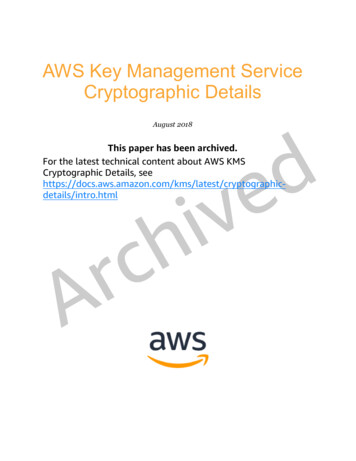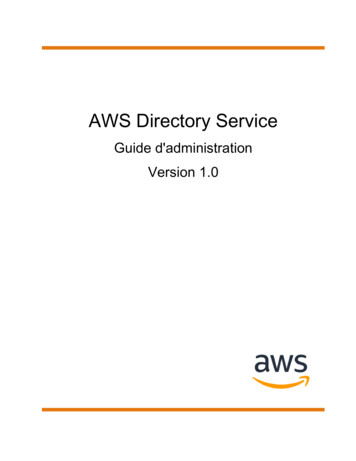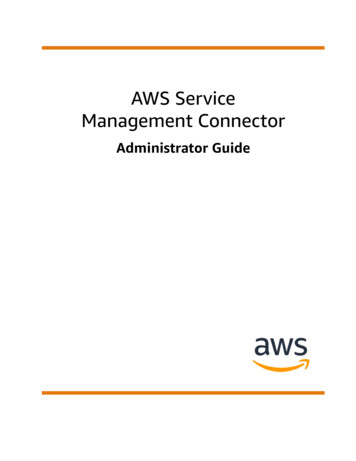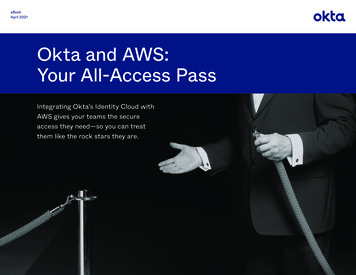
Transcription
AWS Key Management ServiceCryptographic DetailsAugust 2018deThis paper has been archived.For the latest technical content about AWS KMSCryptographic Details, aphicdetails/intro.htmlcrAvih
Amazon Web Services – AWS KMS Cryptographic DetailsAugust 2018 2018, Amazon Web Services, Inc. or its affiliates. All rights reserved.NoticesThis document is provided for informational purposes only. It represents thecurrent AWS product offerings and practices as of the date of issue of thisdocument, which are subject to change without notice. Customers are responsiblefor making their own independent assessment of the information in thisdocument. Any use of AWS products or services is provided “as is” withoutwarranty of any kind, whether express or implied. This document does not createany warranties, representations, contractual commitments, conditions orassurances from AWS, its affiliates, suppliers, or licensors. The responsibilitiesand liabilities of AWS to its customers are controlled by AWS agreements, andthis document is not part of, nor does it modify, any agreement between AWSand its customers.vihdecrAPage 2 of 42
Amazon Web Services – AWS KMS Cryptographic DetailsAugust 2018ContentsAbstract4Introduction4Design Goals6Background7deCryptographic Primitives7Basic Concepts10Customer’s Key HierarchyvihUse CasesAmazon EBS Volume EncryptionClient-side EncryptioncrACustomer Master KeysImported Master KeysEnable and Disable KeyKey DeletionRotate Customer Master KeyCustomer Data Operations131315171922222323Generating Data Keys24Encrypt26Decrypt26Re-Encrypting an Encrypted Object28Domains and the Domain StatePage 3 of 421129Domain Keys30Exported Domain Tokens30Managing Domain State31Internal Communication Security33
Amazon Web Services – AWS KMS Cryptographic DetailsAugust 2018HSM Security Boundary33Quorum-Signed Commands34Authenticated Sessions35Durability Protection36References38deAppendix - Abbreviations and KeysAbbreviations40Keys41vihContributorsDocument RevisionscrAAbstract404242AWS Key Management Service (AWS KMS) provides cryptographic keys andoperations secured by FIPS 140-2 [1] certified hardware security modules(HSMs) scaled for the cloud. AWS KMS keys and functionality are used bymultiple AWS Cloud services, and you can use them to protect data in yourapplications. This whitepaper provides details on the cryptographic operationsthat are executed within AWS when you use AWS KMS.IntroductionAWS KMS provides a web interface to generate and manage cryptographic keysand operates as a cryptographic service provider for protecting data. AWS KMSoffers traditional key management services integrated with AWS services toprovide a consistent view of customers’ keys across AWS, with centralizedmanagement and auditing. This whitepaper provides a detailed description of thecryptographic operations of AWS KMS to assist you in evaluating the featuresoffered by the service.AWS KMS includes a web interface through the AWS Management Console,command line interface, and RESTful API operations to request cryptographicPage 4 of 42
Amazon Web Services – AWS KMS Cryptographic DetailsAugust 2018operations of a distributed fleet of FIPS 140-2 validated hardware securitymodules (HSM)[1]. The AWS Key Management Service HSM is a multichipstandalone hardware cryptographic appliance designed to provide dedicatedcryptographic functions to meet the security and scalability requirements of AWSKMS. You can establish your own HSM-based cryptographic hierarchy underkeys that you manage as customer master keys (CMKs). These keys are madeavailable only on the HSMs for the necessary cycles needed to process yourcryptographic request. You can create multiple CMKs, each represented by its keyID. You can define access controls on who can manage and/or use CMKs bycreating a policy that is attached to the key. This allows you to define applicationspecific uses for your keys for each API operation.devihcrAFigure 1: AWS KMS architectureAWS KMS is a tiered service consisting of web-facing KMS hosts and a tier ofHSMs. The grouping of these tiered hosts forms the AWS KMS stack. All requeststo AWS KMS must be made over the Transport Layer Security protocol (TLS) andterminate on an AWS KMS host. AWS KMS hosts only allow TLS with aciphersuite that provides perfect forward secrecy [2]. The AWS KMS hosts useprotocols and procedures defined within this whitepaper to fulfill those requeststhrough the HSMs. AWS KMS authenticates and authorizes your requests usingthe same credential and policy mechanisms that are available for all other AWSAPI operations, including AWS Identity and Access Management (IAM).Page 5 of 42
Amazon Web Services – AWS KMS Cryptographic DetailsAugust 2018Design GoalsAWS KMS is designed to meet the following requirements.Durability: The durability of cryptographic keys is designed to equal that of thehighest durability services in AWS. A single cryptographic key can encrypt largevolumes of customer data accumulated over a long time period. However, dataencrypted under a key becomes irretrievable if the key is lost.deQuorum-based access: Multiple Amazon employees with role-specific accessare required to perform administrative actions on the HSMs. There is nomechanism to export plaintext CMKs. The confidentiality of your cryptographickeys is crucial.vihAccess control: Use of keys is protected by access control policies defined andmanaged by you.Low-latency and high throughput: AWS KMS provides cryptographicoperations at latency and throughput levels suitable for use by other services inAWS.crARegional independence: AWS provides regional independence for customerdata. Key usage is isolated within an AWS Region.Secure source of random numbers: Because strong cryptography dependson truly unpredictable random number generation, AWS provides a high-qualityand validated source of random numbers.Audit: AWS records the use of cryptographic keys in AWS CloudTrail logs. Youcan use AWS CloudTrail logs to inspect use of your cryptographic keys, includinguse of keys by AWS services on your behalf.To achieve these goals, the AWS KMS system includes a set of KMS operators andservice host operators (collectively, “operators”) that administer “domains.” Adomain is a regionally defined set of AWS KMS servers, HSMs, and operators.Each KMS operator has a hardware token that contains a private and public keypair used to authenticate its actions. The HSMs have an additional private andPage 6 of 42
Amazon Web Services – AWS KMS Cryptographic DetailsAugust 2018public key pair to establish encryption keys that protect HSM statesynchronization.This whitepaper illustrates how the AWS KMS protects your keys and other datathat you want to encrypt. Throughout this document, encryption keys or data youwant to encrypt are referred to as “secrets” or “secret material.”deBackgroundThis section contains a description of the cryptographic primitives and wherethey are used. In addition, it introduces the basic elements of AWS KMS.vihCryptographic PrimitivesAWS KMS uses configurable cryptographic algorithms so that the system canquickly migrate from one approved algorithm, or mode, to another. The initialdefault set of cryptographic algorithms has been selected from FederalInformation Processing Standard (FIPS-approved) algorithms for their securityproperties and performance.crAEntropy and Random Number GenerationAWS KMS key generation is performed on the KMS HSMs. The HSMs implementa hybrid random number generator that uses the NIST SP800-90A DeterministicRandom Bit Generator (DRBG) CTR DRBG using AES-256[3]. It is seeded witha nondeterministic random bit generator with 384-bits of entropy and updatedwith additional entropy to provide prediction resistance on every call forcryptographic material.EncryptionAll symmetric key encrypt commands used within HSMs use the AdvancedEncryption Standards (AES) [4], in Galois Counter Mode (GCM) [5] using 256bit keys. The analogous calls to decrypt use the inverse function.AES-GCM is an authenticated encryption scheme. In addition to encryptingplaintext to produce ciphertext, it computes an authentication tag over theciphertext and any additional data over which authentication is required(additionally authenticated data, or AAD). The authentication tag helps ensurePage 7 of 42
Amazon Web Services – AWS KMS Cryptographic DetailsAugust 2018that the data is from the purported source and that the ciphertext, and AAD, havenot been modified.Frequently, AWS omits the inclusion of the AAD in our descriptions, especiallywhen referring to the encryption of data keys. It is implied by surrounding text inthese cases that the structure to be encrypted is partitioned between the plaintextto be encrypted and the cleartext AAD to be protected.deAWS KMS provides an option for you to import CMK key material instead ofrelying on the service to generate the key. This imported key material can beencrypted using RSAES-PKCS1-v1 5 or RSAES-OAEP [6] to protect the keyduring transport to the KMS HSM. The RSA key pairs are generated on KMSHSMs. The imported key material is decrypted on a KMS HSM, and reencryptedunder AES-GCM before being stored by the service.vihKey Derivation FunctionsA key derivation function is used to derive additional keys from an initial secretor key. AWS KMS uses a key derivation function (KDF) to derive per-call keys forevery encryption under a CMK. All KDF operations use the KDF in counter mode[7] using HMAC [FIPS197][8] with SHA256 [FIPS180] [9]. The 256-bit derivedkey is used with AES-GCM to encrypt or decrypt customer data and keys.crADigital SignaturesAll service entities have an elliptic curve digital signature algorithm (ECDSA) keypair. They perform ECDSA as defined in Use of Elliptic Curve Cryptography(ECC) Algorithms in Cryptographic Message Syntax (CMS)[10] and X9.62-2005:Public Key Cryptography for the Financial Services Industry: The Elliptic CurveDigital Signature Algorithm (ECDSA)[11]. The entities use the secure hashalgorithm defined in Federal Information Processing Standards Publications,FIPS PUB 180-4 [9], known as SHA384. The keys are generated on the curvesecp384r1 (NIST-P384) [12].Digital signatures are used to authenticate commands and communicationsbetween AWS KMS entities. A key pair is denoted as (d, Q), the signing operationas Sig Sign(d, msg), and the verify operation as Verify(Q, msg, Sig). The verifyoperation returns an indication of success or failure.Page 8 of 42
Amazon Web Services – AWS KMS Cryptographic DetailsAugust 2018It is frequently convenient to represent an entity by its public key Q. In thesecases, the identifying information, such as an identifier or a role, is assumed toaccompany the public key.Key EstablishmentAWS KMS uses two different key establishment methods. The first is defined asC(1, 2, ECC DH) in Recommendation for Pair-Wise Key Establishment SchemesUsing Discrete Logarithm Cryptography (Revision 2) [13]. This scheme has aninitiator with a static signing key. The initiator generates and signs an ephemeralelliptic curve Diffie-Hellman (ECDH) key, intended for a recipient with a staticECDH agreement key. This method uses one ephemeral key and two static keysusing ECDH. That is the derivation of the label C(1, 2, ECC DH). This method issometimes called one-pass ECDH.devihThe second key establishment method is C(2, 2, ECC, DH) [13]. In this scheme,both parties have a static signing key, and they generate, sign, and exchange anephemeral ECDH key. This method uses two static keys and two ephemeral keysusing ECDH. That is the derivation of the label C(2, 2, ECC, DH). This method issometimes called ECDH ephemeral or ECDHE. All ECDH keys are generated onthe curve secp384r1 (NIST-P384) [12].crAEnvelope EncryptionA basic construction used within many cryptographic systems is envelopeencryption. Envelope encryption uses two or more cryptographic keys to secure amessage. Typically, one key is derived from a longer-term static key k, andanother key is a per-message key, msgKey, which is generated to encrypt themessage. The envelope is formed by encrypting the message, ciphertext Encrypt(msgKey, message), encrypting the message key with the long-termstatic key, encKey Encrypt(k, msgKey), and packaging the two values (encKey,ciphertext) into a single structure, or envelope encrypted message.The recipient, with access to k, can open the enveloped message by firstdecrypting the encrypted key and then decrypting the message.AWS KMS provides the ability to manage these longer-term static keys andautomate the process of envelope encryption of your data.Page 9 of 42
Amazon Web Services – AWS KMS Cryptographic DetailsAugust 2018AWS KMS uses envelope encryption internally to secure confidential materialbetween service endpoints.In addition to the encryption capabilities provided within the KMS service, theAWS Encryption SDK [14] provides client-side envelope encryption libraries. Youcan use these libraries to protect your data and the encryption keys used toencrypt that data.deBasic ConceptsThis section introduces some basic AWS KMS concepts that are elaborated onthroughout this whitepaper.vihCustomer master key (CMK): A logical key that represents the top of yourkey hierarchy. A CMK is given an Amazon Resource Name (ARN) that includes aunique key identifier, or key ID.Alias: A user-friendly name, or alias, can be associated with a CMK. The aliascan be used interchangeably with key ID in many of the AWS KMS APIoperations.crAPermissions: A policy attached to a CMK that defines permissions on the key.The default policy allows any principals that you define, as well as allowing theAWS account root user to add IAM policies that reference the key.Grants: Grants are intended to allow delegated use of CMKs when the durationof usage is not known at the outset. One use of grants is to define scoped-downpermissions for an AWS service. The service uses your key to do asynchronouswork on your behalf on encrypted data in the absence of a direct-signed API callfrom you.Data keys: Cryptographic keys generated on HSMs under a CMK. AWS KMSallows authorized entities to obtain data keys protected by a CMK. They can bereturned both as plaintext (unencrypted) data keys and as encrypted data keys.Ciphertexts: Encrypted output of AWS KMS is referred to as customerciphertext or just ciphertext when there is no confusion. Ciphertext containsPage 10 of 42
Amazon Web Services – AWS KMS Cryptographic DetailsAugust 2018encrypted data with additional information that identifies the CMK to use in thedecryption process.Encryption context: A key–value pair map of additional informationassociated with AWS KMS–protected information. AWS KMS uses authenticatedencryption to protect data keys. The encryption context is incorporated into theAAD of the authenticated encryption in AWS KMS–encrypted ciphertexts. Thiscontext information is optional and not returned when requesting a key (or anencryption operation). But if used this context value is required to successfullycomplete a decryption operation. An intended use of the encryption context is toprovide additional authenticated information that can be used to enforce policiesand be included in the AWS CloudTrail logs. For example, a key–value pair of{"key name":"satellite uplink key"} could be used to name the data key.Subsequently, whenever the key is used, a AWS CloudTrail entry is made thatincludes “key name”: “satellite uplink key.” This additional information canprovide useful context to understand why a given master key was used.devihcrACustomer’s Key HierarchyYour key hierarchy starts with a top-level logical key, a CMK. A CMK represents acontainer for top-level key material and is uniquely defined within the AWSservice namespace with an ARN. The ARN includes a uniquely generated keyidentifier, a CMK key ID. A CMK is created based on a user-initiated requestthrough AWS KMS. Upon reception, AWS KMS requests the creation of an initialHSM backing key (HBK) to be placed into the CMK container. All such HSMresident-only keys are denoted in red. The HBK is generated on an HSM in thedomain and is designed never to be exported from the HSM in plaintext. Instead,the HBK is exported encrypted under HSM-managed domain keys. Theseexported HBKs are referred to as exported key tokens (EKTs).The EKT is exported to a highly durable, low-latency storage. You receive an ARNto the logical CMK. This represents the top of a key hierarchy, or cryptographiccontext, for you. You can create multiple CMKs within your account and setpolicies on your CMKs like any other AWS-named resource.Within the hierarchy of a specific CMK, the HBK can be thought of as a version ofthe CMK. When you want to rotate the CMK through AWS KMS, a new HBK iscreated and associated with the CMK as the active HBK for the CMK. The olderPage 11 of 42
Amazon Web Services – AWS KMS Cryptographic DetailsAugust 2018HBKs are preserved and can be used to decrypt and verify previously protecteddata, but only the active cryptographic key can be used to protect newinformation.devihcrAFigure 2: CMK hierarchyYou can make requests through AWS KMS to use your CMKs to directly protectinformation or request additional HSM-generated keys protected under yourCMK. These keys are called customer data keys, or CDKs. CDKs can be returnedencrypted as ciphertext (CT), in plaintext, or both. All objects encrypted under aCMK (either customer-supplied data or HSM-generated keys) can be decryptedonly on an HSM via a call through AWS KMS.The returned ciphertext, or the decrypted payload, is never stored within AWSKMS. The information is returned to you over your TLS connection to AWS KMS.This also applies to calls made by AWS services on your behalf.We summarize the key hierarchy and the specific key properties in the followingtable.Page 12 of 42
Amazon Web Services – AWS KMS Cryptographic DetailsAugust 2018KeyDescriptionLifecycleDomain keyA 256-bit AES-GCM key only in memory of an HSM usedto wrap versions of the CMKs, the HSM backing keys.Rotated daily1HSM backing keyA 256-bit symmetric key only in memory of an HSM usedto protect customer data and keys. Stored encryptedunder domain keysRotated yearly2(optional config.)Data encryption keyA 256-bit AES-GCM key only in memory of an HSM usedto encrypt customer data and keys. Derived from an HBKfor each encryption.Used once perencrypt, andregenerated ondecryptCustomer data keyUser-defined key exported from HSM in plaintext andciphertext. Encrypted under an HSM backing key andreturned to authorized users over TLS channel.Rotation and usecontrolled byapplicationdevihUse CasesThis whitepaper presents two use cases. The first demonstrates how AWS KMSperforms server-side encryption with CMKs on an Amazon Elastic Block Store(Amazon EBS) volume. The second is a client-side application that demonstrateshow you can use envelope encryption to protect content with AWS KMS.crAAmazon EBS Volume EncryptionAmazon EBS offers volume encryption capability. Each volume is encryptedusing AES-256-XTS [15]. This requires two 256-bit volume keys, which you canthink of as one 512-bit volume key. The volume key is encrypted under a CMK inyour account. For Amazon EBS to encrypt a volume for you, it must have accessto generate a volume key (VK) under a CMK in the account. You do this byproviding a grant for Amazon EBS to the CMK to create data keys and to encryptand decrypt these volume keys. Now Amazon EBS uses AWS KMS with a CMK togenerate AWS KMS–encrypted volume keys.Page 13 of 421AWS KMS may from time to time relax domain key rotation to at most weekly toaccount for domain administration and configuration tasks.2Default service master keys created and managed by AWS KMS on your behalf areautomatically rotated every 3 years.
Amazon Web Services – AWS KMS Cryptographic DetailsAugust 2018devihFigure 3: Amazon EBS volume encryption with AWS KMS keyscrAEncrypting data being written to an Amazon EBS volume involves five steps:1. Amazon EBS obtains an encrypted volume key under a CMK through AWSKMS over a TLS session and stores the encrypted key with the volumemetadata.2. When the Amazon EBS volume is mounted, the encrypted volume key isretrieved.3. A call to AWS KMS over TLS is made to decrypt the encrypted volume key.AWS KMS identifies the CMK and makes an internal request to an HSM inthe fleet to decrypt the encrypted volume key. AWS KMS then returns thevolume key back to the Amazon Elastic Compute Cloud (Amazon EC2)host that contains your instance over the TLS session.4. The volume key is used to encrypt and decrypt all data going to and fromthe attached Amazon EBS volume. Amazon EBS retains the encryptedvolume key for later use in case the volume key in memory is no longeravailable.Page 14 of 42
Amazon Web Services – AWS KMS Cryptographic DetailsAugust 2018Client-side EncryptionThe AWS Encryption SDK [14] includes an API operation for performingenvelope encryption using a CMK from AWS KMS. For completerecommendations and usage details see the related documentation [14]. Clientapplications can use the AWS Encryption SDK to perform envelope encryptionusing AWS KMS.de// Instantiate the SDKfinal AwsCrypto crypto new AwsCrypto();// Set up the KmsMasterKeyProvider backed by the default credentialsfinal KmsMasterKeyProvider prov new KmsMasterKeyProvider(keyId);// Do the encryptionfinal byte[] ciphertext crypto.encryptData(prov, message);vihThe client application can execute the following steps:crA1. A request is made under a CMK for a new data key. An encrypted data keyand a plaintext version of the data key are returned.2. Within the AWS Encryption SDK, the plaintext data key is used to encryptthe message. The plaintext data key is then deleted from memory.3. The encrypted data key and encrypted message are combined into a singleciphertext byte array.Figure 4: AWS Encryption SDK envelope encryptionPage 15 of 42
Amazon Web Services – AWS KMS Cryptographic DetailsAugust 2018The envelope-encrypted message can be decrypted using the decryptfunctionality to obtain the originally encrypted message.final AwsCrypto crypto new AwsCrypto();final KmsMasterKeyProvider prov new KmsMasterKeyProvider(keyId);// Decrypt the datafinal CryptoResult byte[], KmsMasterKey res crypto.decryptData(prov, ciphertext);// We need to check the master key to ensure that the// assumed key was usedif (!res.getMasterKeyIds().get(0).equals(keyId)) {throw new IllegalStateException("Wrong key id!");}byte[] plaintext res.getResult();devih1. The AWS Encryption SDK parses the envelope-encrypted message toobtain the encrypted data key and make a request to AWS KMS to decryptthe data key.crA2. The AWS Encryption SDK receives the plaintext data key from AWS KMS.3. The data key is then used to decrypt the message, returning the initialplaintext.Figure 5: AWS Encryption SDK envelope decryptionPage 16 of 42
Amazon Web Services – AWS KMS Cryptographic DetailsAugust 2018Customer Master KeysA CMK refers to a logical key that may refer to one or more HBKs. It is generatedas a result of a call to the CreateKey API call.The following is the CreateKey request syntax.de{"Description": "string","KeyUsage": "string",“Origin”: “string”;"Policy": "string"vih}The request accepts the following data in JSON format.crAOptional Description: Description of the key. We recommend that you choosea description that helps you decide whether the key is appropriate for a task.Optional KeyUsage: Specifies the intended use of the key. Currently thisdefaults to “ENCRYPT/DECRYPT”, since only symmetric encryption anddecryption are supported.Optional Origin: The source of the CMK's key material. The defaultis “AWS KMS”. In addition to the default value “AMS KMS”, the value “EXTERNAL”may be used to create a CMK without key material so that you can import keymaterial from your existing key management infrastructure. The use ofEXTERNAL is covered in the following section on Imported Master Keys.Optional Policy: Policy to attach to the key. If the policy is omitted, the key iscreated with the default policy (below) that enables IAM users with AWS KMSpermissions, as well as the root account to manage it.For details on the policy, rguide/key-policies.html.Page 17 of 42
Amazon Web Services – AWS KMS Cryptographic DetailsAugust 2018The call returns a response containing an ARN with the key identifier.arn:aws:kms: region : owningAWSAccountId :key/ keyId If the Origin is AWS KMS, after the ARN is created, a request to an HSM is madeover an authenticated session to provision an HBK. The HBK is a 256-bit key thatis associated with this CMK key ID. It can be generated only on an HSM and isdesigned never to be exported outside of the HSM boundary in cleartext. An HBKis generated on the HSM and encrypted under the current domain key DK0.These encrypted HBKs are referred to as EKTs. Although the HSMs can beconfigured to use a variety of key wrapping methods, the current implementationuses the authenticated encryption scheme known as AES-256 in Galois CounterMode (GCM) [5]. As part of the authenticated encryption mode, some cleartextexported key token metadata can be protected.devihcrAThis is stylistically represented as EKT Encrypt(DK0, HBK).Two fundamental forms of protection are provided to your CMKs and thesubsequent HBKs: authorization policies set on your CMKs, and thecryptographic protections on your associated HBKs. The remaining sectionsdescribe the cryptographic protections and the security of the managementfunctions in AWS KMS.In addition to the ARN, a user-friendly name can be associated with the CMK bycreating an alias for the key. Once an alias has been associated with a CMK, thealias can be used in place of the ARN.Multiple levels of authorizations surround the use of CMKs. AWS KMS enablesseparate authorization policies between the encrypted content and the CMK. Forinstance, an AWS KMS envelope-encrypted Amazon Simple Storage Service(Amazon S3) object inherits the policy on the Amazon S3 bucket. However,access to the necessary encryption key is determined by the access policy on theCMK.Page 18 of 42
Amazon Web Services – AWS KMS Cryptographic DetailsAugust 2018For the latest information about authentication and authorization policies forAWS KMS, rguide/control-access.html.Imported Master KeysAWS KMS provides a mechanism for importing the cryptographic material usedfor an HBK. As described in the section on Customer Master Keys earlier, whenthe CreateKey command is used with Origin set to EXTERNAL, a logical CMK iscreated that contains no underlying HBK. The cryptographic material must beimported using the ImportKeyMaterial API call. This feature allows you tocontrol the key creation and durability of the cryptographic material. It isrecommended that if you use this feature you take significant caution in thehandling and durability of these keys in your environment. For complete detailsand recommendations for importing master keys, rImportPrior to importing the key material for an imported master key, you must obtainthe necessary parameters to import the key.The following is the GetParametersForImport request syntax.{"KeyId": "string","WrappingAlgorithm": "string",“WrappingKeySpec” : “string”}KeyId: A unique key identifier for a CMK. This value can be a globally uniqueidentifier, an ARN, or an alias.WrappingAlgorithm: The algorithm you use when you encrypt your keymaterial. The valid values are “RSAES OAEP SHA256”, “RSAES OAEP SHA1”, or“RSAES PKCS1 V1 5”. AWS KMS recommends that you usePage 19 of 42
Amazon Web Services – AWS KMS Cryptographic DetailsAugust 2018RSAES OAEP SHA256. You may have to use another key-wrapping algorithm,depending on what your key management infrastructure supports.WrappingKeySpec: The type of wrapping key (public key) to return in theresponse. Only RSA 2048-bit public keys are supported. The only valid value is“RSA 2048”.This call results in a request from the AWS KMS host to an HSM to generate anew RSA 2048-bit key pair. This key pair is used to import an HBK for thespecified CMK key ID. The private key is protected and accessible only by anHSM member of the domain.{"ImportToken": blob,"KeyId": "string","PublicKey": blob,"ValidTo": numbercrA}devihA successful call results in the following return values.ImportToken: A token that contains metadata to ensure that your key materialis imported correctly. Store this value and send it in a subsequentImportKeyMaterial request.KeyId: The CMK to use when you subsequently import the key material. This isthe same CMK specified in the request.PublicKey: The public key to use to encrypt your key material. The public key isencoded as specified in section A.1.1 of PKCS#1 [6], an ASN.1 DER encoding ofthe RSAPublicKey. It is the ASN.1 encoding of two integers as an ASN.1 sequence.ValidTo: The time at which the import token and public key expire. These itemsare valid for 24 hours. If you do not use them for a subsequentImportKeyMaterial request within 24 hours, you must retrieve new ones. Theimport token and public key from the same response must be used together.Page 20 of 42
Amazon Web Services – AWS KMS Cryptographic DetailsAugust 2018ImportKeyMaterialThe ImportKeyMaterial request imports the necessary cryptographic materialfor the HBK. The cryptographic material must be a 256-bit symmetric key. Itmust be encrypted using the algorithm specified in WrappingAlgorithm underthe returned public key from a recent GetParametersForImport request.ImportKeyMaterial takes the following arguments.de{"EncryptedKey": blob,"ExpirationModel": "string","ImportToken": blob,"KeyId": "string","ValidTo": numbervih}crAEncryptedKey: The encrypted key ma
modules (HSM)[1]. The AWS Key Management Service HSM is a multichip standalone hardware cryptographic appliance designed to provide dedicated cryptographic functions to meet the security and scalability requirements of AWS KMS. You can establish your own HSM-based cryptographic hierarchy under keys that you manage as customer master keys (CMKs).










![[AWS Black Belt Online Seminar] AWS X-Ray](/img/17/20200526-blackbelt-x-ray.jpg)